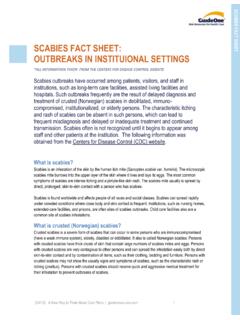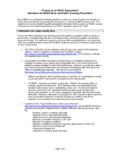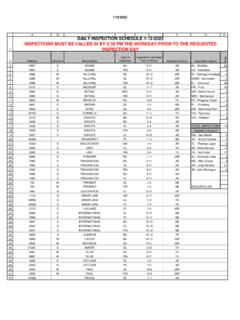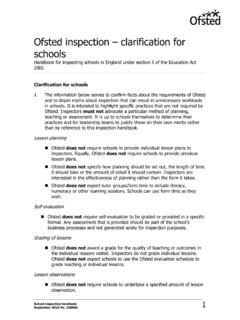Transcription of COMMERCIAL KITCHEN FIRE SAFETY
1 COMMERCIAL KITCHEN FIRE SAFETY . COMMERCIAL KITCHEN FIRE. SAFETY . COMMERCIAL grade kitchens are a common feature found in senior living communities. Operation of a COMMERCIAL grade KITCHEN , many SAFETY considerations should be addressed, including food SAFETY , employee and volunteer SAFETY , and fire SAFETY . This fact sheet addresses the specific issues associated with providing adequate fire SAFETY for your KITCHEN . COMMERCIAL KITCHENS. COMMERCIAL cooking operations are defined as kitchens that have cooking equipment that produce grease and grease laden vapors.
2 This includes flat grills, char broilers and deep fat fryers. The typical residential range (electric or gas) would not be considered a grease producing appliance. Other equipment, such as ovens, microwaves and steam kettles also fall into the non-grease producing appliance category. The following is information regarding two of the most common types of equipment that produce grease and/or grease laden vapors. Deep Fat Fryers Deep fat fryers are a major cause of KITCHEN fires. Oil can splash and easily come into contact with an open flame from an adjacent piece of cooking equipment, such as a gas-fired range top.
3 A 16-inch clearance must be maintained between the deep fat fryer and the open flame cooking equipment. If a 16-inch clearance is not possible, a vertical steel barrier extending 12 inches above the top of the deep fat fryer or open flame appliance(s) can be used as an alternative means of protection. The normal temperature range for food service frying is 325. to 375 degrees Fahrenheit. As the oil temperature increases, so does the risk of an accidental grease fire. All deep fat This photo illustrates the correct installation of a metal baffle plate between the fryers should be equipped with a high temperature limiting open flames from the range and the deep fat fryer.
4 Metal baffles should be device, which will shut off the fuel or energy in the event used only when there is not sufficient space available to provide a 16-inch the cooking oil exceeds a temperature of 475 degrees clearance between the deep fat fryer and any source of open flames. Fahrenheit. CM 17265 (12/11) COMMERCIAL KITCHEN Fire SAFETY | 1. Flat Grills/Griddles Flat grills and griddles are typically used for frying hamburgers and bacon. When used for this type of cooking, grease and grease laden vapors will be produced.
5 To adequately control the fire hazard associated with these types of cooking operations, two fire protection components must be installed: a hood and ventilation system and an automatic extinguishing system. HOOD AND VENTILATION SYSTEM. A KITCHEN hood and ventilation system will include an exhaust hood or canopy, ductwork, fan system, and a means of providing adequate make-up air. This system will effectively remove the heat, grease and grease laden vapors from the cooking area. Installation The hood and ventilation system should be professionally installed according to National Fire Protection Association Standard 96.
6 (NFPA 96 Standard for Ventilation Control and Fire Protection of COMMERCIAL Cooking Operations.). Local fire officials also should be consulted, as additional requirements under county and/or municipal codes could apply. The hood must be equipped with the appropriate grease removal filters. Only baffle style filters comply with NFPA 96 and should be used in cooking operations that produce a moderate to heavy amount of grease. Mesh filters are not appropriate for COMMERCIAL cooking operations and do not comply with NFPA 96.
7 Filters should be cleaned regularly to prevent the build-up of grease. Lighting units should be equipped with tight fitting protective globe lights with steel enclosures that are mounted on the outer surface of the hood. All electrical equipment should be installed in accordance with NFPA 70 National Electric Code by a licensed electrician. The photo to the left is an example of KITCHEN appliances that are properly equipped with an appropriate hood and ventilation system. 2 | COMMERCIAL KITCHEN Fire SAFETY CM 17265 (02/12).
8 COMMERCIAL KITCHEN FIRE SAFETY . Maintenance Hoods, grease-removal devices, fans, ducts and other equipment should be serviced by a qualified contractor at intervals necessary to prevent the accumulation of grease. Frequency of cleaning will depend upon the amount of grease observed during an inspection. A six month interval is standard, but unusually heavy grease accumulation may require more frequent cleaning. A written cleaning schedule should be established indicating the methods of cleaning and the time intervals.
9 Following the inspection or cleaning, a label indicating the date cleaned and the name of the servicing company should be prominently This photo shows ductwork from a cooking area that has a heavy accumulation of displayed. It is recommended that this label be grease. Maintaining and cleaning the hood and ventilation system is crucial, as the attached to the exterior of the hood in a visible buildup of grease can become a serious fire hazard. The hood and ventilation system should be inspected and cleaned by a certified contractor every six months.
10 Location. AUTOMATIC EXTINGUISHING SYSTEM. All cooking equipment that produces grease or grease- laden vapors should be equipped with an approved automatic extinguishing system. The automatic extinguishing system should meet the Underwriters Laboratory (UL) 300 standard. UL 300 went into effect in 1994 as the result of the high temperature oils used in cooking today. Dry-chemical systems do not adequately extinguish grease fires associated with using these high temperature cooking oils. The automatic extinguishing system should be inspected and serviced every six months only a qualified contractor.








